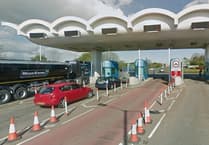COUNCILLORS are being told that there are ‘no easy solutions’ over poor visibility which had led to incidents and near misses at a junction in North Devon, writes Daniel Clark, local democracy reporter.
The Brandis Corner junction, on the A3072 in the village, has seen five reported injury collisions in a 30-mile radius in the last five years of validated data.
The straight nature of the A3072, with good forward visibility, encourages high traffic speeds through the junction, which itself lies in a slight dip on the A3072, and consequently is not evident to drivers until they are almost at the junction.
Visibility is also constrained for drivers exiting the side road to enter the A3072 by the frontages of the properties on either side, especially so for drivers wanting to turn right as they are not able to see left until they are some way over the stop line.
Councillors on the Torridge District Council’s highways and traffic orders committee had previously called for consideration be given to the safety issues at Brandis Corner relating to poor visibility which had led to incidents and near misses.
A site visit took place on January 17, but Meg Booth, chief officer for highways, infrastructure development and waste, in her report for the next committee meeting, said that due to the physical layout of the junction, particularly the proximity of properties, it is not feasible to change the alignment.
Her report added: “During the site visit an impromptu meeting was held with a local resident who owns land on the south side of the junction and The Old Post Office on the east side of the junction. The resident has stated that he would not be willing to give up any land on the south side of the junction to allow a change in the road alignment.
“Without changing the alignment of the road it is not possible to introduce any features that are likely to reduce vehicle speeds on the A3072. Devon County Council current policy also stipulates that speed limits are not to be reduced for isolated hazards, but states instead that hazards should be appropriately signed. Therefore, it is not proposed that the speed limit will be changed.”
Instead, she proposed two options for the committee to consider, which would see the direction signs cleaned and ensure that suitable forward visibility of the signs is maintained, to make the junction more visible and to apply light coloured High Friction Surfacing on both approaches of the A3072 to make drivers more aware that they are approaching a junction and to aid braking.
Keep clear marking would also be painted on the side road to allow anyone who has moved over the stop line to enter the A3072 to reverse back if traffic is approaching.
She added: “Safety at this junction has been raised as an issue by local members, but due to the physical layout of the junction, particularly the proximity of properties, it is not feasible to change the alignment.
“Therefore, there is no easy solution, and there have been attempts to solve the problem in the past. The proposals outlined present a practical approach.”




Comments
This article has no comments yet. Be the first to leave a comment.